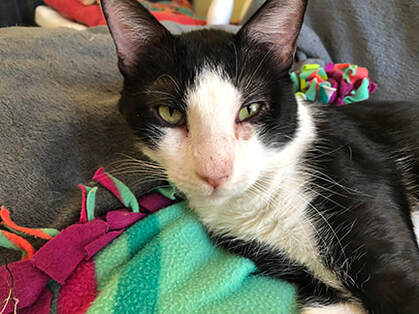
Feline epiphora, simply put, is an overflow of tears from a cat’s eyes. A symptom rather than a specific disease, it’s associated with a variety of conditions.
Normally, a thin film of tears is produced to lubricate your cat’s eyes, leaving the excess fluid to drain into the tear ducts, located in the corner of each eye next to her nose, which, in turn, drain tears into the back of her nose and throat. Usually associated with insufficient drainage of this tear film is a blockage of the tear ducts or poor eyelid function due to some sort of deformity. Conversely, epiphora may result from the excessive production of tears.
The most obvious signs of epiphora are dampness or wetness beneath her eyes, reddish-brown staining of the fur beneath her eyes, odor, skin irritation and skin infection. In some instances, you may even see tears rolling down your kitty’s face.
A vet visit is the first step in determining if there is an underlying cause for her excess tear production. Some of these causes include abnormal eyelashes (distichia or ectopic cilia), allergies, anatomical abnormalities such as rolled in eyelids (entropion) or rolled out eyelids (ectropion), conjunctivitis (viral or bacterial), corneal ulcers, eye infections, eye injuries and glaucoma.
Should these causes be eliminated, it’s essential to determine whether or not there IS proper and adequate tear drainage. Your vet will perform a thorough ocular exam, paying special attention to your cat’s tear ducts and nearby tissues, and checking for any signs of inflammation or other abnormalities. One of the simplest tests involves placing a drop of fluorescein stain in the eye, holding her head slightly downward, and watching for drainage into her nose. If the drainage system is functioning normally, the stain should appear in her nose within minutes. If none is seen, it doesn’t definitively diagnose a blocked tear duct and merits further investigation.
Your cat will then be anesthetized and a special instrument inserted into the duct to flush out its contents. In some instances, the duct may not have opened during her development, and if so, it can be surgically opened during this procedure. If chronic infections or allergies have caused the ducts to narrow, flushing may help widen them. If, however, the cause is related to another eye condition, other treatment options may include surgery.
If your cat has an eye infection, your vet may prescribe a topical antibiotic such as oxytetracycline, triple antibiotic ointments intended for pets or topical antivirals like idoxuridine. If, however, she has an upper respiratory infection or nasal discharge or can’t tolerate eye drops, your vet may prescribe an oral antibiotic like doxycycline or azithromycin.
Unless an underlying cause can be found and treated, most cats with epiphora will experience intermittent episodes all of their lives. If your cat’s facial anatomy (such brachycephalic breeds as Persians and Himalayans) prevents adequate drainage of the tear film, some degree of epiphora will persist regardless, and in most cases, no significant problems may arise, and the tear staining may merely be cosmetic. The most you can do in this case is clean the area under your kitty’s eyes with gentle wipes designed specifically for pets.









 RSS Feed
RSS Feed